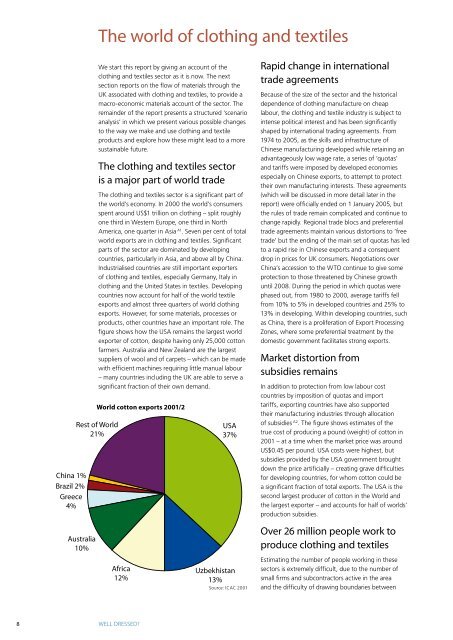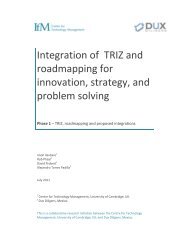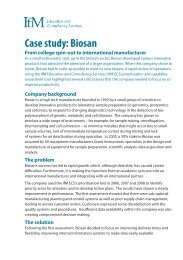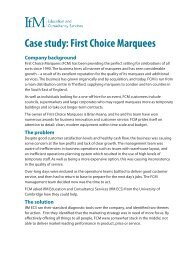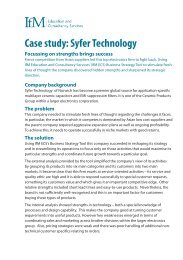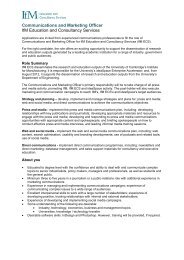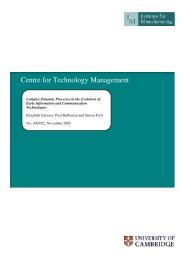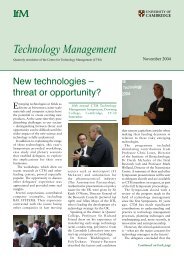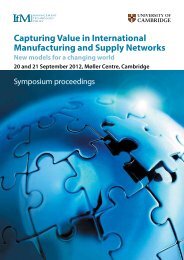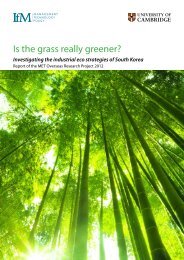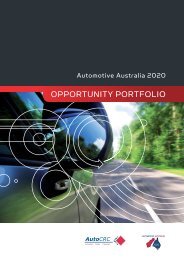The present and future sustainability of clothing and textiles in the ...
The present and future sustainability of clothing and textiles in the ...
The present and future sustainability of clothing and textiles in the ...
You also want an ePaper? Increase the reach of your titles
YUMPU automatically turns print PDFs into web optimized ePapers that Google loves.
<strong>The</strong> world <strong>of</strong> <strong>cloth<strong>in</strong>g</strong> <strong>and</strong> <strong>textiles</strong><br />
Ch<strong>in</strong>a 1%<br />
Brazil 2%<br />
Greece<br />
4%<br />
Australia<br />
10%<br />
We start this report by giv<strong>in</strong>g an account <strong>of</strong> <strong>the</strong><br />
<strong>cloth<strong>in</strong>g</strong> <strong>and</strong> <strong>textiles</strong> sector as it is now. <strong>The</strong> next<br />
section reports on <strong>the</strong> flow <strong>of</strong> materials through <strong>the</strong><br />
UK associated with <strong>cloth<strong>in</strong>g</strong> <strong>and</strong> <strong>textiles</strong>, to provide a<br />
macro-economic materials account <strong>of</strong> <strong>the</strong> sector. <strong>The</strong><br />
rema<strong>in</strong>der <strong>of</strong> <strong>the</strong> report <strong>present</strong>s a structured ‘scenario<br />
analysis’ <strong>in</strong> which we <strong>present</strong> various possible changes<br />
to <strong>the</strong> way we make <strong>and</strong> use <strong>cloth<strong>in</strong>g</strong> <strong>and</strong> textile<br />
products <strong>and</strong> explore how <strong>the</strong>se might lead to a more<br />
susta<strong>in</strong>able <strong>future</strong>.<br />
<strong>The</strong> <strong>cloth<strong>in</strong>g</strong> <strong>and</strong> <strong>textiles</strong> sector<br />
is a major part <strong>of</strong> world trade<br />
<strong>The</strong> <strong>cloth<strong>in</strong>g</strong> <strong>and</strong> <strong>textiles</strong> sector is a significant part <strong>of</strong><br />
<strong>the</strong> world’s economy. In 2000 <strong>the</strong> world’s consumers<br />
spent around US$1 trillion on <strong>cloth<strong>in</strong>g</strong> – split roughly<br />
one third <strong>in</strong> Western Europe, one third <strong>in</strong> North<br />
America, one quarter <strong>in</strong> Asia A1 . Seven per cent <strong>of</strong> total<br />
world exports are <strong>in</strong> <strong>cloth<strong>in</strong>g</strong> <strong>and</strong> <strong>textiles</strong>. Significant<br />
parts <strong>of</strong> <strong>the</strong> sector are dom<strong>in</strong>ated by develop<strong>in</strong>g<br />
countries, particularly <strong>in</strong> Asia, <strong>and</strong> above all by Ch<strong>in</strong>a.<br />
Industrialised countries are still important exporters<br />
<strong>of</strong> <strong>cloth<strong>in</strong>g</strong> <strong>and</strong> <strong>textiles</strong>, especially Germany, Italy <strong>in</strong><br />
<strong>cloth<strong>in</strong>g</strong> <strong>and</strong> <strong>the</strong> United States <strong>in</strong> <strong>textiles</strong>. Develop<strong>in</strong>g<br />
countries now account for half <strong>of</strong> <strong>the</strong> world textile<br />
exports <strong>and</strong> almost three quarters <strong>of</strong> world <strong>cloth<strong>in</strong>g</strong><br />
exports. However, for some materials, processes or<br />
products, o<strong>the</strong>r countries have an important role. <strong>The</strong><br />
figure shows how <strong>the</strong> USA rema<strong>in</strong>s <strong>the</strong> largest world<br />
exporter <strong>of</strong> cotton, despite hav<strong>in</strong>g only 25,000 cotton<br />
farmers. Australia <strong>and</strong> New Zeal<strong>and</strong> are <strong>the</strong> largest<br />
suppliers <strong>of</strong> wool <strong>and</strong> <strong>of</strong> carpets – which can be made<br />
with efficient mach<strong>in</strong>es requir<strong>in</strong>g little manual labour<br />
– many countries <strong>in</strong>clud<strong>in</strong>g <strong>the</strong> UK are able to serve a<br />
significant fraction <strong>of</strong> <strong>the</strong>ir own dem<strong>and</strong>.<br />
World cotton exports 2001/2<br />
Rest <strong>of</strong> World<br />
21%<br />
Africa<br />
12%<br />
USA<br />
37%<br />
Uzbekhistan<br />
13%<br />
Source: ICAC 2001<br />
Rapid change <strong>in</strong> <strong>in</strong>ternational<br />
trade agreements<br />
Because <strong>of</strong> <strong>the</strong> size <strong>of</strong> <strong>the</strong> sector <strong>and</strong> <strong>the</strong> historical<br />
dependence <strong>of</strong> <strong>cloth<strong>in</strong>g</strong> manufacture on cheap<br />
labour, <strong>the</strong> <strong>cloth<strong>in</strong>g</strong> <strong>and</strong> textile <strong>in</strong>dustry is subject to<br />
<strong>in</strong>tense political <strong>in</strong>terest <strong>and</strong> has been significantly<br />
shaped by <strong>in</strong>ternational trad<strong>in</strong>g agreements. From<br />
1974 to 2005, as <strong>the</strong> skills <strong>and</strong> <strong>in</strong>frastructure <strong>of</strong><br />
Ch<strong>in</strong>ese manufactur<strong>in</strong>g developed while reta<strong>in</strong><strong>in</strong>g an<br />
advantageously low wage rate, a series <strong>of</strong> ‘quotas’<br />
<strong>and</strong> tariffs were imposed by developed economies<br />
especially on Ch<strong>in</strong>ese exports, to attempt to protect<br />
<strong>the</strong>ir own manufactur<strong>in</strong>g <strong>in</strong>terests. <strong>The</strong>se agreements<br />
(which will be discussed <strong>in</strong> more detail later <strong>in</strong> <strong>the</strong><br />
report) were <strong>of</strong>ficially ended on 1 January 2005, but<br />
<strong>the</strong> rules <strong>of</strong> trade rema<strong>in</strong> complicated <strong>and</strong> cont<strong>in</strong>ue to<br />
change rapidly. Regional trade blocs <strong>and</strong> preferential<br />
trade agreements ma<strong>in</strong>ta<strong>in</strong> various distortions to ‘free<br />
trade’ but <strong>the</strong> end<strong>in</strong>g <strong>of</strong> <strong>the</strong> ma<strong>in</strong> set <strong>of</strong> quotas has led<br />
to a rapid rise <strong>in</strong> Ch<strong>in</strong>ese exports <strong>and</strong> a consequent<br />
drop <strong>in</strong> prices for UK consumers. Negotiations over<br />
Ch<strong>in</strong>a’s accession to <strong>the</strong> WTO cont<strong>in</strong>ue to give some<br />
protection to those threatened by Ch<strong>in</strong>ese growth<br />
until 2008. Dur<strong>in</strong>g <strong>the</strong> period <strong>in</strong> which quotas were<br />
phased out, from 1980 to 2000, average tariffs fell<br />
from 10% to 5% <strong>in</strong> developed countries <strong>and</strong> 25% to<br />
13% <strong>in</strong> develop<strong>in</strong>g. With<strong>in</strong> develop<strong>in</strong>g countries, such<br />
as Ch<strong>in</strong>a, <strong>the</strong>re is a proliferation <strong>of</strong> Export Process<strong>in</strong>g<br />
Zones, where some preferential treatment by <strong>the</strong><br />
domestic government facilitates strong exports.<br />
Market distortion from<br />
subsidies rema<strong>in</strong>s<br />
In addition to protection from low labour cost<br />
countries by imposition <strong>of</strong> quotas <strong>and</strong> import<br />
tariffs, export<strong>in</strong>g countries have also supported<br />
<strong>the</strong>ir manufactur<strong>in</strong>g <strong>in</strong>dustries through allocation<br />
<strong>of</strong> subsidies A2 . <strong>The</strong> figure shows estimates <strong>of</strong> <strong>the</strong><br />
true cost <strong>of</strong> produc<strong>in</strong>g a pound (weight) <strong>of</strong> cotton <strong>in</strong><br />
2001 – at a time when <strong>the</strong> market price was around<br />
US$0.45 per pound. USA costs were highest, but<br />
subsidies provided by <strong>the</strong> USA government brought<br />
down <strong>the</strong> price artificially – creat<strong>in</strong>g grave difficulties<br />
for develop<strong>in</strong>g countries, for whom cotton could be<br />
a significant fraction <strong>of</strong> total exports. <strong>The</strong> USA is <strong>the</strong><br />
second largest producer <strong>of</strong> cotton <strong>in</strong> <strong>the</strong> World <strong>and</strong><br />
<strong>the</strong> largest exporter – <strong>and</strong> accounts for half <strong>of</strong> worlds’<br />
production subsidies.<br />
Over 26 million people work to<br />
produce <strong>cloth<strong>in</strong>g</strong> <strong>and</strong> <strong>textiles</strong><br />
Estimat<strong>in</strong>g <strong>the</strong> number <strong>of</strong> people work<strong>in</strong>g <strong>in</strong> <strong>the</strong>se<br />
sectors is extremely difficult, due to <strong>the</strong> number <strong>of</strong><br />
small firms <strong>and</strong> subcontractors active <strong>in</strong> <strong>the</strong> area<br />
<strong>and</strong> <strong>the</strong> difficulty <strong>of</strong> draw<strong>in</strong>g boundaries between<br />
<br />
WELL DRESSED?


